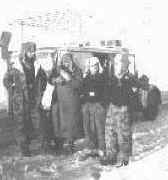| The photos on this
page are from the personal collection of Unteroffizier Albert Bertsch, who served with the
Nachrichtenabteiling (Signals Battalion) of the Großdeutschland Division. Thanks to
Herr Bertsch and Jeremy Cauley for these photos and the permission to post them.
Herr Bertsch would love to contact veterans of his old battalion; anyone who can help is
urged to contact the webmaster. Thanks to Jeremy
again on 15-22 Sep 2003, when he provided extra hi-resolution images to share. Herr Bertsch also consented to answer some questions
via email; I am pleased to present our interview here. |
 |
At right, Albert is pictured as he appeared
in 1969, serving in Baden-Soellingen, Germany as a chaplain in the Canadian Armed Forces.
Note the cross above his right breast pocket, and the use of Royal Canadian Air Force
insignia; this would change as Unification took effect throughout the Canadian forces..
Albert moved to Canada, as a fair number of German veterans did after the war, in
1952, and volunteered to serve in the military of his adopted land. In all Albert
served 14 years in the Canadian Forces, an experience he describes as a "happy"
one. |
 |
| At left, Albert as he appeared
in the Second World War, wearing the black AFV uniform he wore as a member of the Armoured
Signals Regiment "Grossdeutschland". The standard "Totenkopf" or
"Death's Head" skull devices are worn on the collar patches, edged in lemon
yellow "waffenfarbe" or branch of service colour; this colour is repeated on the
soutache braid over the national cockade on the black service cap. |
|
| How
old were you when you joined the Army? I didn't join the Army. When I was drafted in 1940 I
was 20 years old.
What did your mother and
father think about you joining?
My father had died in 1938 and
neither I nor my mother had any say in it. |
 |
Left, Albert as
an Obergefreiter wearing the ribbon of the Kriegsverdienstkreuz II Klasse (War Merit Cross
Second Class). Albert wears the black AFV uniform, which was common in the signals
battalion of the GD Division, and the fairly rare 1942 model of the Feldmütze, with two
button front. Soldier at right is not a GD soldier, but a troop returning to the
front after home leave. |
| Did
you serve in any other units before Großdeutschland? When I was drafted I was send to signal
training at Langemarck-Kaserne in Bielefeld. |
| Why did you
become a signaller? Again,
I had no choice, but I was quite happy about it.
What kind of skills did you
learn during your training?
Morse code, encoding and decoding. |
|

|
Herr Bertsch was
a tall man; photographed here returning to the front with soldiers from other units after
home leave. |
| Was it hard? Not really, it was interesting.
Who presented you with the
Iron Cross Second Class?
If I remember right, it was General
von Manteuffel. (Webmaster's note - General von Manteuffel commanded the GD Division after
serving in Africa)
What did the hometown
newspaper have to say about the award?
Nothing. The Iron Cross Second
Class was so common almost everybody got it. |

|
| The
webmaster originally described the photo above right as soldiers clearing communications
lines of frost in winter. Thanks to Jeff "Speedbump" Myers of the Combat Mission
Forum, who has provided a more likely description of what this photo actually depicts.
In Jeff's words: " My wife is a
native Hungarian. I have travelled around much of Hungary including the plains area
where they have a very unique type of cowboy. For the first couple of days, I would
notice these "see-saw" contraptions in many of the fields. I finally
summoned the courage to ask my in-laws what they were and was told they were wells.
Where Westerners have the winch type of system to draw up water, the Hungarians (and I can
only assume much of the rest of that part of the world) use this method. It is
weighted much like a crossing gate, so that a single person could easily swing it up and
down, in this case bringing up a full bucket of well water." Thanks again
Jeff. |
| Was it
publicized at home? No.
Which fronts did you serve
on?
The Russian front.
How long did you serve in
Russia?
From spring 1942 until the end of
lthe war. (Webmaster's note - during this period, Albert received two weeks leave in 1943
and again in 1944) |

|
| Did you
attend NCO School?
I am not aware of any NCO schools
during the war. We were promoted in the field as the positions were needed.
Who was your best friend in
the Army?
That is difficult to say. In a war
you have good comrades and I had many. To develop a friendship was difficult, because the
persons in your group changed so often over the years.
Which of your officers did
you respect the most - and why? |
The
padded winteranzug (Winter Uniform) was a welcome addition to the wardrobe of German
soldiers in the East; fine examples of the splinter pattern pants and reversible padded
jacket can be seen in these two photos, along with fur hats.
 |
| I remember
two Captains (Company commanders) and also a Battalion commander. Of one of
these captains I know that he was very brave. I know of all three that they were politically clean according to my
standards which means they were no NAZIS. I am sure there were more of the same
attitude but to express it demanded a great amount of trust. The wrong word could be
deadly. And that applied to every soldier in the German Wehrmacht.
|